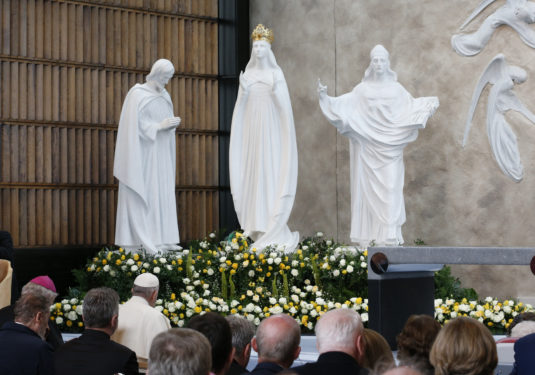
By William Schmitt
PROSPECT HEIGHTS — An iconic symbol of Irish Catholicism offers a sobering reminder about faith in New York City as well as on the Emerald Isle.
Our Lady of Knock is remembered at an apparition site that Pope Francis, one year ago, declared to be Ireland’s international “Eucharistic and Marian” shrine.
The Blessed Virgin Mary, who visited Knock’s village church in 1879, is credited with delivering a message of resilience following the country’s devastating potato famine, also called “the Great Hunger.”
The visionaries saw Mary standing alongside St. Joseph, St. John the Evangelist, and Jesus Christ in the form of a lamb — the Lamb of God — on an altar with a cross in the background. No words were spoken in the hours-long apparition, but it was received as an inspiring image of instruction and heavenly solidarity; amid lingering misery from the 1845-1852 famine, it is said the Knock parishioners had been fearing their potato crop would fail again in 1879.
Many descendants of Irish immigrants in the U.S. venerate Our Lady of Knock as a connection to the teaching and consolation of the Catholic faith. In addition, one of the visionaries who witnessed her miraculous appearance went on to live in New York under very humble conditions.
The emigre, listed in historical records as John Joseph Curry, was only 4 or 5 years old when he became the youngest villager to see the Church-affirmed apparition, as recounted in a 2017 Irish Echo article by New York-based genealogist Patricia Phelan.
As Phelan told The Tablet, she was moved to apply her research skills to Curry’s incomplete story after visiting the Knock Shrine with her husband several years ago.
“I was impressed by Knock, its lovely grounds, its Irish warmth, how it had branched out from a place of pilgrimage to a place that offered counseling, care for the elderly, and more,” Phelan said via email.
Using Knock Shrine resources and official U.S. documents, she reported that Curry was a railroad employee in the Midwest for a period, but hard times followed. He lived for a while at one of New York City’s early facilities serving homeless people. He then was cared for by the Little Sisters of the Poor at the Sacred Heart Home for indigent elderly.
Curry died in 1943 and was buried in Resurrection Cemetery, Farmingdale, New York, with only a small grave marker. But the Church did not forget the visionary. In 2017, he was reinterred at Old St. Patrick’s Cathedral, now titled the Basilica of St. Patrick’s Old Cathedral, on Mulberry Street in lower Manhattan, at the direction of Cardinal Timothy Dolan of the Archdiocese of New York.
Likewise, the Church has not forgotten the Knock Shrine, where many miracles are said to have taken place. Devotion to Our Lady of Knock goes along with a love for Ireland and its faith that has energized Irish immigrants in the U.S. for many decades. That energy is seen within the Irish community in the Diocese of Brooklyn, according to Father Christopher Heanue, rector of the Co-Cathedral of St. Joseph in Prospect Heights.
“The Irish have been so key to building churches and parishes” in Brooklyn and Queens, Father Heanue said. Reflecting his own Irish roots, he spoke with admiration of historically Irish communities centered around Teresa of Avila Church; known as a fertile field for vocations, that church may have led the diocese in the number of nuns and other religious sisters it produced.
Father Heanue said he was also privileged to be rector at a church with St. Joseph as its patron because the Knock Shrine apparition included Mary’s husband — and indeed all three members of the Holy Family.
In his youth, Father Heanue traveled to Ireland frequently as his parents visited their homeland: “We went to Knock every summer.”
Soon after his ordination in 2015, his family joined him as he traveled to the shrine to celebrate a Mass of Thanksgiving in the apparition chapel. He called visiting the site “life-changing.”
Our Lady of Knock “is so important for the Irish people,” he said, and Mary’s apparitions have touched hearts. “She has a history of appearing where people need it most and when they need it.”
Meanwhile, Phelan, who had researched the story of John Joseph Curry, also acknowledged today’s distractions from faith.
She criticized the tendency in Ireland itself to shift the focus of St. Patrick’s Day toward partying and abusing alcohol.
Although the excess partying on St. Patrick’s Day in New York at first put a damper on the feast for her and her husband years ago, “we have enjoyed going to and marching in the parade many times, finding it a lovely, family-oriented day,” she told The Tablet.
News coverage of partying that goes to extremes is not “representative of the day,” Phelan said.
Father Heanue said Our Lady of Knock represents the good that still exists in religion for the Irish in their homeland and abroad.
“I pray the Knock Shrine continues to be a beacon of faith and a symbol of hope for the Church to return to.”
